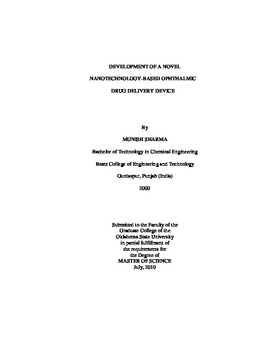| dc.description.abstract | Topical delivery by eye drops, which accounts for approximately 90% of all ophthalmic formulations, is extremely inefficient. Only approximately 5% of the drug applied as drops penetrates the outer layer of the eye and reaches the target, while the rest is lost due to tear drainage. A number of conditions like glaucoma, conjunctivitis, and proliferative retinopathy need a sustained release of drug inside the eye for drug to be therapeutically effective. In addition to eye drops, other ocular drug delivery systems include drug-loaded liposomes or nanoparticles and drug-loaded contact lenses (hydrogels). Particle drug delivery systems also have difficulty penetrating the outer layer of the eye and can be lost before the drug can be released. Contact lens delivery systems often show a burst release with poor release over long periods of time. To improve sustain delivery of drugs to the eye, we have designed a novel system that includes drug-loaded nanoparticles suspended within a thin, membrane that can be attached to a standard commercial-grade contact lens for support. The lens system will provide constant contact with the eye's surface and the particles will supply a continuous release of medication, resulting in more drug reaching the target. First, PLGA nanoparticles, synthesized by the emulsion solvent evaporation technique, are loaded with the hydrophobic drug lidocaine. Next, the nanoparticles are loaded within a thin, collagen membrane that can be stored dried, and later rehydrated and attached to a contact lens for delivery to the eye. Drug loading and drug release rates must be controlled within the novel delivery system in order to ensure that therapeutic levels of the drug are delivered safely to the eye. The PLGA nanoparticles were found to be irregular in shape, 247 nm in diameter, and contained 5.17 wt% of lidocaine. The nanoparticles loaded into the collagen membrane did not have a significant effect on light transmittance through the membrane, compared to a commercially available contact lens. For initial drug release in the first 48 hours, the complete lens system, nanoparticles only, and collagen membrane only released 21.8%, 53.0% and 7.6% of the initial drug loading, respectively. For the first 400 hours tested, the complete lens system, nanoparticles only, and collagen membrane only released 20.8%, 63.9 and 7.0% of the initial drug loading, respectively. | |
